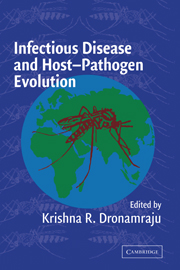Book contents
- Frontmatter
- Contents
- List of Contributors
- Introduction
- PART ONE J. B. S. HALDANE
- PART TWO MALARIAL PARASITES
- 3 Evolutionary Genetics of Plasmodium falciparum, the Agent of Malignant Malaria
- 4 Evolutionary Biology of Malarial Parasites
- 5 G6PD Deficiency and Malarial Resistance in Humans: Insights from Evolutionary Genetic Analyses
- 6 The Enigma of Plasmodium vivax Malaria and Erythrocyte Duffy Negativity
- PART THREE OTHER PARASITES
- PART FOUR GENETIC AND EVOLUTIONARY CONSIDERATIONS
- Index
- Plate Section
- References
5 - G6PD Deficiency and Malarial Resistance in Humans: Insights from Evolutionary Genetic Analyses
Published online by Cambridge University Press: 10 August 2009
- Frontmatter
- Contents
- List of Contributors
- Introduction
- PART ONE J. B. S. HALDANE
- PART TWO MALARIAL PARASITES
- 3 Evolutionary Genetics of Plasmodium falciparum, the Agent of Malignant Malaria
- 4 Evolutionary Biology of Malarial Parasites
- 5 G6PD Deficiency and Malarial Resistance in Humans: Insights from Evolutionary Genetic Analyses
- 6 The Enigma of Plasmodium vivax Malaria and Erythrocyte Duffy Negativity
- PART THREE OTHER PARASITES
- PART FOUR GENETIC AND EVOLUTIONARY CONSIDERATIONS
- Index
- Plate Section
- References
Summary
THE ROLE OF G6PD IN MALARIA RESISTANCE
Malaria, resulting from infection by the Plasmodium falciparum and Plasmodium vivax parasites, is the leading cause of death in the global human population. Each year 500 million people suffer from malaria, resulting in approximately 2 million deaths annually. During the course of human evolution in regions where malaria is prevalent, naturally occurring genetic defense mechanisms have evolved for resisting infection by the Plasmodium parasite. Most of the human genes that are thought to provide resistance against malarial infection are expressed in red blood cells or play a role in the immune system (Hill, 2001). These loci include: HLA, α- and β-globins, Duffy factor (FY), tumor necrosis factor (TNF), and glucose-6-phosphate dehydrogenase (G6PD).
G6PD is an important “housekeeping” enzyme in the glycolytic pathway for glucose metabolism. G6PD also plays a critical role in maintaining the balance of NADPH, a necessary cofactor for cell detoxification. Although several enzymes can recycle this essential cofactor, G6PD is the sole generator of NADPH in the red blood cells and alone may prevent oxidative damage and severe anemia. Because of its role in preventing oxidative stress within the cell, G6PD may also play a role in longevity (Ho et al., 2000).
G6PD deficiency is the most common enzymopathy of humans, affecting an estimated 400 million people worldwide (Vulliamy et al., 1992).
- Type
- Chapter
- Information
- Infectious Disease and Host-Pathogen Evolution , pp. 113 - 140Publisher: Cambridge University PressPrint publication year: 2004
References
- 8
- Cited by



